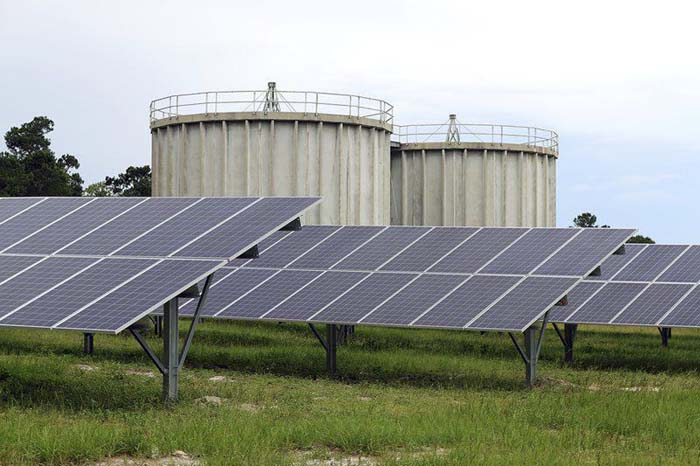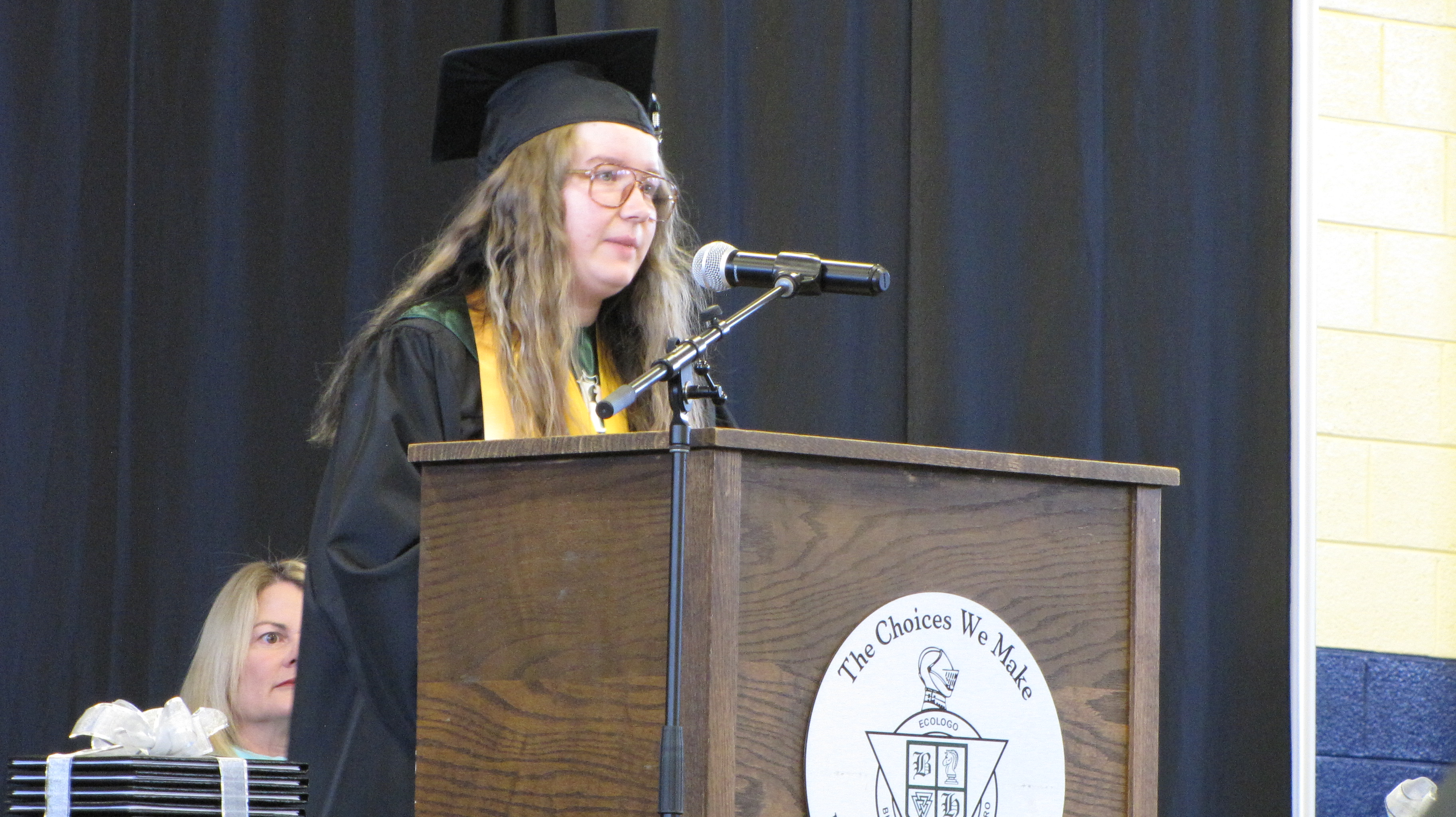SunLight Project: Here comes the sun
Published 10:23 am Saturday, July 15, 2017

- Derrek Vaughn/The Valdosta Daily TimesSolar panels were installed at the site of the old Withlacoochee Wastewater Treatment Plant as the land can not be used for any other purpose.
Few things are as certain as the sun rising every morning in the east and setting every evening in the west.
The certainty is alluring. If a tiny seed can capture the energy of the sun to grow into a massive tree, then surely people can use it to power a standard 100 watt light bulb.
Solar energy was once considered to be the stuff of science fiction or futuristic thinkers. Burning coal and fossil fuels, building dams and and even nuclear reactors to produce energy were all considered viable sources of power generation. But solar power generation is here and here to stay.
Still, like most things, there is a catch.
The Sunlight Project team in Georgia and North Florida took a look into one of the world’s fastest-growing markets.
In Georgia, with more than 197 solar companies at work, investing $79 million for residential and business installation, solar energy production can no longer be ignored or seen as niche.
According to Solar Energy Industries Association, Georgia produces more than 1,000 megawatts of solar power, which is close to double a typical coal plant. The Peach State also has 167,000 homes powered by solar and nearly 4,000 solar-related jobs. Clearly, it’s not just eco-friendly people jumping on the solar-power bandwagon.
James LaValley, a Valdosta resident, wanted to invest in his home — not for himself but for his children. In 2015, the 74-year-old retired New Yorker decided he would go solar. After a quick internet search, he found a business in Vidalia, known more for its onions than solar power, that would come to his place in Valdosta to install solar panels to his roof.
“The way this guy put it seemed to me like a no-brainer,” LaValley said. “Looked to me like I wouldn’t be paying any energy bill at all.”
Installation took two weeks. It cost LaValley $30,000, but with federal tax breaks, he only ended up $20,000 in the hole. The cost didn’t bother him. It was worth the investment, he thought and he said he was told his investment would be paid back in less than five years.
The useful life of a solar panel is estimated at 20 to 30 years.
LaValley didn’t see a downside. He believed his energy bill would go from $170 a month to as low as $15, maybe $10. After the panels were up and running, he became excited when he saw they were producing more energy than his house was using.
“It was great. I thought my bill would go even lower,” LaValley said. “I was happy, then I saw the actual bill and it was like I was struck in the heart.”
His bill went down but not by as much as he wanted it to — as he needed it to. When LaValley brought this up to the installer, who was also a lawyer, he told LaValley it was normal and this was a battle he had been fighting in court for years.
“I felt ripped off, like I had been taken advantage of,” LaValley said.
His solar panels were still producing way more energy than he was using but his energy wasn’t worth as much as he was told it would be. His next step was to find a local professional to manage his solar panels.
LaValley turned to Ron Jackson, project manager of South Georgia Solar Power. Jackson said solar power has benefited the utility companies at the expense of homeowners who have high-cost panels installed.
He said people such as LaValley invest their own money, feeding the energy into a utility provider’s grid only to be compensated a fraction of the amount utility companies charge for the same power.
Energy that LaValley sells to a utility company such as Georgia Power is purchased for less than the cost of the energy Georgia Power sells back to LaValley.
For example, Georgia Power can buy any power LaValley doesn’t use for five cents per unit and sell it back to him at 15 cents.
“He is making energy for them and not seeing any benefit,” Jackson said. “He should be getting $20 a month from them, not a bill.”
The problem in LaValley’s situation has to do with energy storage. He is producing too much energy and has nowhere to put it except into Georgia Power’s grid. He could buy a Tesla Powerwall, a giant battery meant for storing solar energy, but those can cost about $5,000.
For LaValley, that’s more money then he bargained for, and the situation he is in is why Georgia Power, the largest subsidiary of Southern Company, one of the nation’s largest generators of electricity, recommends for people to speak to them before investing in solar power.
John Kraft, Georgia Power representative, said the company is aware of situations such as LaValley’s. The company offers tremendous help to those interested in solar, he said. Georgia Power will work with them and even send representatives to their home to look into the matter.
“What we’re really doing is trying to find out why they want solar,” Kraft said. “There can be a number of reasons, like for the environment or for a cheaper electric bill. Sometimes we have to tell them that there are cheaper ways to lower your electric bill than installing solar panels.”
Kraft said he sees a lot of customers thinking they can install solar panels and never pay an electric bill again. However, unless someone has a place to put the power, they will continue paying power bills.
The person will have to sell their unused power back to a utility company and buy back power during times when the panels aren’t generating power, at night or early in the morning, for instance.
The utility company offers to pay the producer only as much as it costs to produce solar power. If a utility company can produce solar energy at a solar farm for 5 cents per unit, it isn’t going to pay a residential producer a higher rate for energy it doesn’t need.
From LaValley’s point of view, this isn’t fair.
He is producing Georgia Power energy and thinks he is not getting a fair rate. However, why should Georgia Power pay him more for something it already produces for less?
Local, state and federal governments struggle with how to regulate the solar power industry while not stifling its growth.
The Sunlight Project looked into city and county laws regulating solar power across the coverage area — Valdosta, Dalton, Thomasville, Milledgeville, Tifton and Moultrie, Ga., and Live Oak, Jasper and Mayo, Fla., along with the surrounding counties.
Regulating the Sun
Thomas County commissioners broached the idea of solar-panel legislation last year. In October, they approved a 30-day moratorium on solar installations that in November was extended to six months.
The county lifted the moratorium in late April, two weeks ahead of its scheduled end. Commissioners have put in place a $1,000 zoning application fee for solar facilities.
Earlier this year, commissioners approved an amendment that split solar use into two categories — one for installations at homes and businesses that would provide power to locations and another for solar farms that would generate power to be sold to utility companies.
Solar farms of more than 200 acres would be considered commercial ventures and permitted in industrial and commercial land use districts and as conditional use in agricultural districts. They would not be permitted in residential zones.
Solar farms of 200 acres or fewer will be classified as a conditional use in agricultural districts and subject to approval on a case-by-case basis. Setbacks for the location of solar facilities are 100 feet from all property lines, with 500-foot setbacks from residences and residential land use districts.
Another provision requires applicants for solar facilities to provide a performance guarantee in the form of a bond, irrevocable letter of credit or other financial security acceptable to Thomas County in the amount of 125 percent of the estimated decommissioning cost, minus the salvageable value, or $50,000, whichever is greater.
Thomas County Commission Chairman Ken Hickey said additional tweaks to legislation might be needed, including a consideration of necessary variances for installers.
“With the solar ordinance, I’ve said all the time, there is no one size fits all. All the land is different. The contours are different. The acreage is different. The topography is different. Everything is different. You need this kind of variance so you can work with people on their projects. Whether you choose to or not, the option will be there,” he said.
Grady County also enacted moratoriums while discussing potential solar facilities.
“One prospective solar farm developer had plans for a very large solar farm that could have large impacts on the county,” Grady County Administrator Carlos Tobar said of the moratoriums. “I wanted to make sure the board of commissioners was aware of such a large development. They all agreed that they should address such a project with an ordinance.”
The first moratorium, 60-days long, was enacted in February and the second brief moratorium was enacted in May. The Grady County Commission approved an ordinance for solar farms, which falls under the county’s land use regulations, in early June.
Grady’s land use ordinances, now including solar farms, require an opaque vegetative buffer along all property lines. Setbacks include 35 feet from all property lines and 300 feet from homes, churches or businesses. The ordinance also includes decommissioning specifics for the solar facility owner if the facility discontinues operation.
“We certainly know from our neighboring counties that solar farms generate significant tax revenue for a community,” Tobar said. “That reduces the tax burden on our property owners and that is a great thing.”
One solar farm is under construction in Grady County — small enough that the previous administration did not address it legislatively, Tobar said.
Colquitt County has approved three solar projects so far this year. The first was a 10-acre Hannah Solar project. Hannah Solar is a North American Board of Certified Energy Practitioners certified solar power company. The site produces 2 megawatts and is up and running, said Justin Cox, director of the county’s compliance office
The county faced an influx of permit requests near the deadline for bids to Georgia Power. Commissioners enacted a 90-day moratorium while it studied the issue and drafted a solar ordinance.
Since the moratorium was lifted, two potential projects have been permitted, Cox said. One is a large 95.9-megawatt development covering 420 acres on eight parcels of land issued to eagle Solar in May.
The other, permitted in April to Odom Solar, would have 260 acres of panels producing 20 megawatts.
Both were among the contract bids to Georgia Power.
“Both had special-use permits granted,” Cox said. “Whether they’re going to proceed with them, that’s unknown.”
Two other companies have requested permit documents.
“They’ve got the paperwork but they haven’t turned anything in,” Cox said.
The City of Valdosta has no local ordinances that directly regulate the use of solar power, said Sementha Mathews, the city public information officer.
From a zoning standpoint, the city simply looks at the use of solar arrays in one of two different categories: “individual use” to augment a particular development, or “solar farm” for the primary purpose of generating electricity to be sold back to the grid.
If a solar panel is attached to a building, the city considers it part of the building. If a solar panel is freestanding, it is considered the same as any other freestanding accessory structure. If it is a solar electric generating facility, it is treated similarly to other such electric-generating facilities.
“The City of Valdosta is leading the state and this part of the country with their commitment to renewable energy resources,” Mathews said.
Sites located within the city limits or on city-owned property are 11 acres of land for Mud Creek Wastewater Treatment Plant; five acres for New Withlacoochee Wastewater Treatment Plant; eight acres at a closed landfill located on Val Tech Road, adjacent to the Valdosta State Prison, along with another 3.5 acres near the shooting range on Val Tech Road.
In the City of Valdosta, sites for solar panels are chosen when the lands no longer have a public use, such as an old landfill.
“The use of solar PD installations is an innovative way for the City of Valdosta to be in the renewable energy game and also generate capital assets off of land that could not be developed for anything else,” Mathews said.
As for Lowndes County, officials said they are supportive of solar energy but the county does not have an active solar power generation program, said Paige Dukes, county clerk. Lowndes County also does not have any laws discouraging or incentivizing solar power.
Neither the City of Tifton nor Tift County has established any moratorium on solar farms.
Who Is Using Solar Power?
When it comes to using solar power, bigger is better. It’s also cheaper.
In 2017, Georgia Power has been looking to boost sun-based generation.
Kraft said the company has made a huge commitment to renewable energy, looking to boost capacity through a mix of solar, wind and biomass by some 1,200 megawatts through its Renewable Energy Development Initiative. This included a bidding process for 525 megawatts that ended earlier this year and an equal amount to be bid in 2019. Of the total of 1,050 megawatts, up to 300 are expected to be generated by wind.
One megawatt is defined as the amount of electricity that will power some 1,000 homes. For example, a typical coal plant is about 600 MW in size, according to the Union of Concerned Scientists.
“We have one of the biggest voluntary solar expansions in the nation,” Kraft said.
He contrasted this voluntary expansion to some states that mandated rapid ramping up of solar earlier, which locked in higher costs before technology improved and cost of production dropped. Currently, the company’s mix includes about 4 percent renewable sources, including hydroelectric, solar and other renewables. About 47 percent is generated with natural gas, 29 percent with coal, and 20 percent nuclear.
Kraft said hydro and other renewables represent 8 percent of total capacity, but solar energy is limited in that it is only made while the sun shines. Georgia Power is diversifying its renewable energy source by buying 250 megawatts of wind power generated in Oklahoma.
Georgia Power parent company Southern Company has a research project in Northwest Georgia involving storing power generated through solar for later use with the Electric Power Research Institute. Georgia Power also has a small research project on the roof of its headquarters’ parking facility, where various types of solar panels are tested.
“Here in the Southeast, we get a lot of cloud cover, a lot of rain and humidity,” Kraft said. “We’re looking at which panels work best in the Southeast. That’s an ongoing project.”
In this environment, the best solar generation is realized in the spring and fall when humidity drops, he said.
“Solar panels are most efficient when it’s cool,” Kraft said.
Currently, the method used to store energy from nuclear plants, which produce a constant output when operating, accounts for nearly all storage that can be put into the system when needed. During times when excess power is generated, water is pumped into storage facilities. When more electricity is needed, the water is released to run downhill to turn turbines.
Georgia Power has designed its increase in renewable generation sources. It only adds more when the cost of production is at or below the cost of generating non-renewable sources of electric power, Kraft said.
In 2015, Tifton granted approvals to Sparrow Hawk Renewable Energy and United Renewable Energy to build a solar farm on 7.11 acres. The application asked for the acreage to be rezoned from multiple residential to suburban agriculture.
The solar farm was built as part of the Georgia Power Renewable Energy project and provides electricity for approximately 125 to 150 homes.
More recently, the new Veterans Affairs Clinic had solar panels installed on its roof.
In Milledgeville and Baldwin County, private solar panels are few and far between. However, the proliferation of solar energy into Georgia’s infrastructure has already hit close to home.
At the Central State Hospital campus, the CSH Local Redevelopment Authority has approved three separate projects to bring solar energy to the hospital grounds. While the projects will not technically fulfill the agency’s stated goal of bringing new jobs to southern Milledgeville, the three mini-farms stand to power the campus’s massive Bobby E. Parham Kitchen and bring the campus $50,000 in payments to rent out the needed space.
The first project is a plan by Atlanta-based Hannah Solar to build more than 14,000 solar panels on top of a closed landfill on the CSH campus and the energy gathered will be sold to Georgia Power as part of its solar buyback program.
Hannah has also planned another 2.2-acre, 1,678-panel farm to be built on top of the Parham building to power its newly-revitalized kitchen (which at one time was touted as the largest commercial kitchen in the world).
The third project is a plan by Birmingham-based Allied Energy to convert roughly 15 acres of non-developed hillside land into 9,375 panels, also to be sold to Georgia Power via the solar buyback. While the Hannah landfill and Allied Energy hillside projects are still awaiting approval by Georgia Power, CSHLRA Director Mike Couch said he believes all three projects can be completed by the end of the year.
Couch said a company as successful as Georgia Power would not shift from fossil-fuel-based energy to what he calls “passive energy,” if there wasn’t value in it.
“The other side of it to me is that it’s just the kind of thing we ought to be working on anyway,” Couch said. “As I understand, the science is only getting better as far as battery storage capability and the lifespan of the panels, so to me we ought to be engaged in that, and it helps us as we approach businesses all over the country.”
Europe is ahead of the game, he said. He lived there for 10 years in the 1980s and ’90s and saw the countryside littered with wind turbines and solar panels.
The SunLight Project team of journalists who contributed to this report includes Patti Dozier, Thomas Lynn, Charles Oliver, Will Woolever, Alan Mauldin and Eve Guevara, and team leader John Stephen. To contact the team, email sunlightproject@gaflnews.com.





